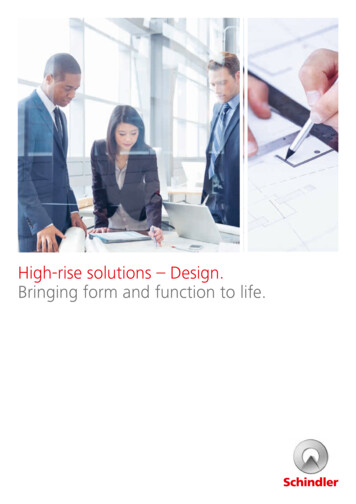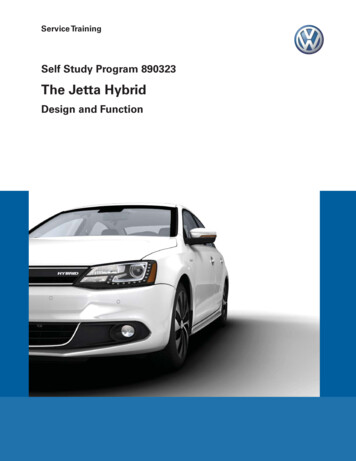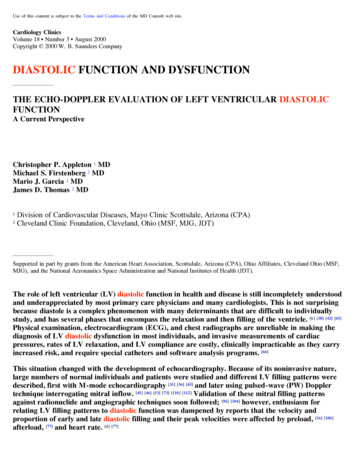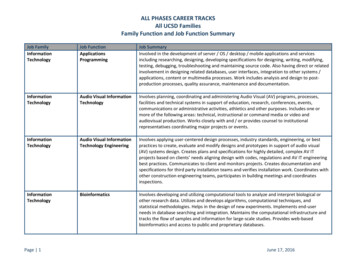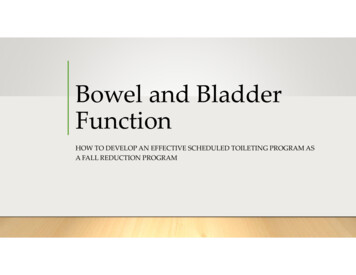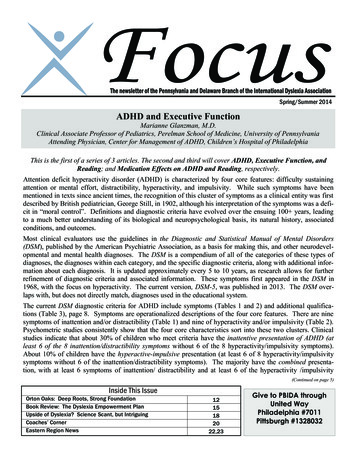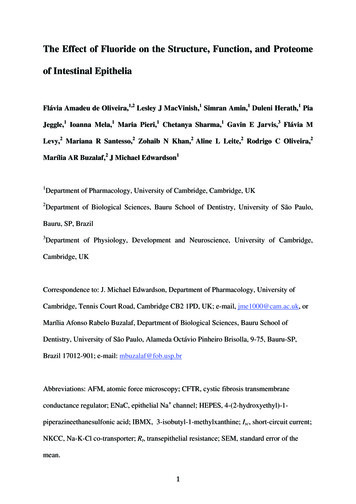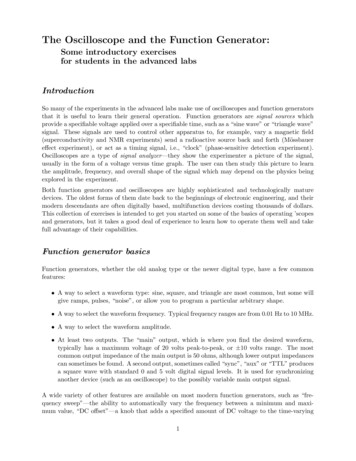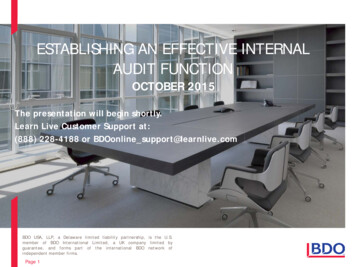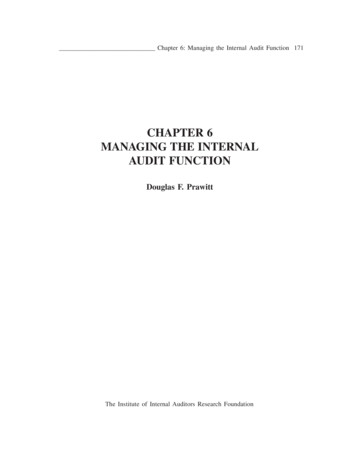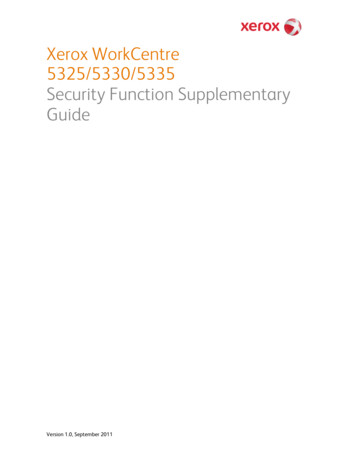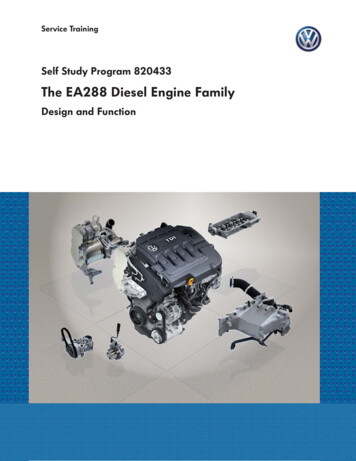
Transcription
Service TrainingSelf Study Program 820433The EA288 Diesel Engine FamilyDesign and Function
Volkswagen Group of America, Inc.Volkswagen AcademyPrinted in U.S.A.Printed 2/2014Course Number SSP 820433 2014 Volkswagen Group of America, Inc.All rights reserved. All information contained in this manual is basedon the latest information available at the time of printing and issubject to the copyright and other intellectual property rights ofVolkswagen Group of America, Inc., its affiliated companies andits licensors. All rights are reserved to make changes at any timewithout notice. No part of this document may be reproduced, storedin a retrieval system, or transmitted in any form or by any means,electronic, mechanical, photocopying, recording or otherwise, normay these materials be modified or reposted to other sites withoutthe prior expressed written permission of the publisher.All requests for permission to copy and redistribute information shouldbe referred to Volkswagen Group of America, Inc.Always check Technical Bulletins and the latest electronic repairinformation for information that may supersede any informationincluded in this booklet.Trademarks: All brand names and product names used in this manualare trade names, service marks, trademarks, or registered trademarks;and are the property of their respective owners.
ContentsIntroduction . . . . . . . . . . . . . . . . . . . . . . . . . . . . . . . . . . . . . . . . . . . . . . . . . . . . 1Engine Mechanics . . . . . . . . . . . . . . . . . . . . . . . . . . . . . . . . . . . . . . . . . . . . . . . 4Engine Management System . . . . . . . . . . . . . . . . . . . . . . . . . . . . . . . . . . . . . 40Service . . . . . . . . . . . . . . . . . . . . . . . . . . . . . . . . . . . . . . . . . . . . . . . . . . . . . . . 67Knowledge Assessment . . . . . . . . . . . . . . . . . . . . . . . . . . . . . . . . . . . . . . . . . 71NoteThis Self-Study Program provides information regardingthe design and function of new models.This Self-Study Program is not a Repair Manual. Thisinformation will not be updated.Important!For maintenance and repair procedures,always refer to the latest electronic serviceinformation.i
Page intentionally left blank
IntroductionEA288 Diesel Engine FamilyVolkswagen is introducing a new family of diesel engines in the 2015 Golf. The engine family has the designation EA288 (EA Entwicklungsauftrag [development order]).The design of this new generation of diesel engines was based on the existing EA189 engine family. Displacement, cylinderspacing, stroke and bore ratio are shared between the EA189 and the new EA288 gasoline engines. The new EA288 enginedesign forms the basis for all future inline diesel engines at Volkswagen.Several sub-assemblies were redesigned in the EA 288 family of 4-cylinder diesel engines to satisfy future emission standards.In this Self-Study Program you will learn about the structure and design of the new EA288 TDI engine, and the functions of theindividual engine subsystems.S514 0011
IntroductionModular Diesel Matrix (MDB)The new EA288 diesel engine family is also called a modular diesel matrix, or MDB. The modular diesel system is the basis forall future inline diesel engines in the Volkswagen Group.The modular diesel matrix is a concept that involves dividing the functional engine components into modules. Depending oncapacity, power output, emission standard and the vehicle class, engines can be assembled from modules and components.14253678109S514 104Basic EngineAttachment Parts1 Modular Camshaft Housing7 Exhaust Manifold Module with Turbocharger2 Cylinder Head8 Intake Manifold with Water-Cooled Charge AirCooler3 Cylinder Block4 Switchable Coolant Pump5 Oil/Vacuum Pump9 Exhaust Purification Module10 Exhaust Gas Recirculation Module6 Timing Drive and Accessory DriveThe modular design meets fuel consumption, exhaust emissions and power delivery demands. It also allows the engines toaccept future modular components that meet upcoming country-specific requirements with minimal costs.2
IntroductionTechnical DataEngine CodeCRBCDesignFour-cylinder inline engineEngine Capacity1968 cm3Bore81.0 mmStroke95.5 mmValves per Cylinder4Compression Ratio16.2:1Maximum Output150 hp (110 kW) from 3500 to 4000 rpmMaximum Torque235 lb/ft (320 Nm) from 1750 to 3000 rpmEngine Management SystemBosch EDC 17FuelUltra-Low Sulfur DieselExhaust Gas AftertreatmentExhaust gas recirculation, oxidizing catalyticconverter, diesel particulate filterEmissions StandardBIN 5Torque and Power 451000 2000 3000 4000Engine speed [rpm]Output [hp]Torque [lb/ft]2.0 TDI Engine10S514 1003
Engine MechanicsCylinder BlockThe EA288 cylinder block is grey cast iron, an alloy of cast iron and flake graphite.The cylinder block has deep screw threads for long cylinder head bolts. This distributes combustion forces through the cylinderblock structure, applying equal pressure distribution on the cylinder head gasket.The design of the cooling channels in the cylinder block provides good cooling in the area between the cylinders.Cylinder Block 2.0L TDI EngineThe cylinder block for the 2.0L TDI engine is available forengines with and without balance shafts.S514 0054
Engine MechanicsCrankshaft GroupCrankshaftPiston and ConrodThe EA288 engine uses a forged crankshaft with fivebearings to distribute the high mechancial loads. Instead ofthe usual eight counterweights, this crankshaft only has fourcounterweights to counteract the rotating forces of inertia.The pistons in the EA288 engine have no valve pockets.Instead, the dish design of the piston crown reduces deadspace and improves the swirl formation of the intake air inthe cylinder.This design reduces the load on the crankshaft bearings.Noise emissions, which may be caused by inherentmovement and vibrations in the engine, have also beenreduced.To improve piston ring area cooling, the pistons have a ringshaped cooling channel into which oil is sprayed via pistonspray nozzles.The conrods are cracked trapezoidal conrods.The toothed belt sprocket that drives the oil pump and thesprocket that drives the balance shafts are an interference fitonto the crankshaft.PistonsBalance ShaftConrodGear Sprocketfor BalanceShaft DriveToothed Belt Sprocketfor Oil Pump DriveCamshaft ToothedSprocket for EngineManagement SystemBalance ShaftS514 0065
Engine MechanicsBalance ShaftsOne version of the 2.0L TDI engine has a balance shaftsystem to reduce crankshaft inertial forces inherent in astraight four-cylinder engine. The balance shaft system hastwo countershafts rotating in opposite directions at doublethe speed of the crankshaft.FunctionThe balance shafts are is driven by a gear wheel driveconnected to the crankshaft. An idler gear between thecrankshaft and one of the balance shafts reverses thedirection of the second balance shaft. Both balance shaftsand the idler gear are axially and radially mounted withroller bearings in the cylinder block to reduce friction.S514 007The roller bearings are lubricated by oil mist in the cylinderblock.The components in the balance shaft systemcannot be replaced in the field because theplay between the gears cannot be adjustedusing workshop tools.Rolling BearingBalance ShaftRolling BearingRolling BearingRolling BearingBalance ShaftRolling BearingRolling BearingCrankshaftIdler Gear for Reversing RotationS514 0166
Engine MechanicsToothed Belt DriveThe engine timing components are driven by the crankshaft via a toothed belt. From the crankshaft, the toothed belt is routedto the belt tensioner, over the camshaft drive wheel, to the drive wheel of the high-pressure pump for the common rail injectionsystem, and then to the drive wheel of the coolant pump. Two idler rollers ensure better meshing of the gear wheels and thetoothed belt.Camshaft Drive WheelIdler RollerHigh Pressure Pump Drive GearTensioning RollerCoolant Pump Drive GearIdler RollerCrankshaft SprocketS514 041Accessory Component DriveTensioningRollerAlternatorThe alternator and the air conditioner compressor are drivenby the crankshaft by a pulley with vibration damper and apoly V-belt. The poly V-belt is tensioned by a spring-loadedbelt tensioner.Pulley withVibrationDamperAir ConditionerCompressorS514 0087
Engine MechanicsCylinder HeadThe aluminum alloy cylinder head of the EA288 engine hasa cross-flow design and a unique placement of intake andexhaust valves. The valves are operated by two camshafts.Because of the arrangement of the intake and exhaustports, each camshaft operates intake and exhaust valves.There is not a separate intake or exhaust camshaft.Cylinder HeadThe camshafts are driven by the crankshaft by a toothed beltand the camshaft gear of one of the camshafts. The twocamshafts are joined by a spur gear.Camshaft HousingS514 042Camshaft HousingThe camshafts are integrated into a closed retaining frame by a thermal joining process. They cannot be separated. Thisprocess ensures a very rigid camshaft bearing while keeping the weight low.To reduce friction, a needle bearing is used for the first bearing that receives the highest forces from the toothed belt drive. Asensor wheel for G40 Camshaft Position Sensor is located on one camshaft. The signal from the Hall sensor tells the ECM thecurrent position of the camshafts.Spur Gear TeethNeedle BearingSender WheelRetaining Frame with CamshaftsHall Sensor G40S514 043The camshafts cannot be removed from the camshaft housing. If there is damage to the camshafts or thehousing, the complete assembly must be replaced.8
Engine MechanicsValve LayoutFor future emission standards, the ‘valve star’ has been rotated to the longitudinal axis of the engine. This means the intake andexhaust ports for each cylinder are positioned one behind the other in the direction of flow. As a result, each camshaft actuatesone intake and exhaust valve per cylinder. The valve layout has been designed to allow maximum air delivery with good swirleffects.Intake AirFirst Exhaust Valve, Cylinder 2First Intake Valve, Cylinder 2Second Intake Valve, Cylinder 2Cylinder 1Second Exhaust Valve, Cylinder 2Exhaust GasS514 059Coolant JacketThe cylinder head has an upper and lower coolant jacket.The lower coolant jacket core has a larger volume, toprovide a high level of heat dissipation in the part of thecylinder head close to the combustion chamber. The flowof coolant from the upper and lower parts merge at thespur gear side of the cylinder head where it exits through acombined outlet.Upper Coolant Jacket CoreOutlet to theConnecting PieceTo provide heat when the engine is cold, the coolant ischanneled out of the upper and lower core, through thecoolant hose connecting piece, and towards the heatercore.Connecting Piecesfor Coolant HosesLower CoolantJacket CoreS514 0479
Engine MechanicsCrankcase BreatherThe crankcase breather components are integrated into the cylinder head cover, with the oil filler neck and the pressureaccumulator for the engine vacuum system.Blow-by gases are returned to the intake side through the crankcase breather.Crankcase venting takes place in several stages for efficient separation. First, the blow-by gases travel from the crankshaft andcamshaft chamber into the “settling volume” area of the cylinder head cover. This is where larger oil drops collect on the wallsand drip down into the cylinder head. Then the oily gases are separated from gas fumes in a cyclone separator. The pressurecontrol valve regulates the transfer of purified gases to the intake manifold, where they enter the combustion chamber.To prevent the passages from freezing in cold climate countries, a heater element is used in the crankcase breather.Heater Element for Crankcase BreatherPressure Regulating ValveVacuum ReservoirFine Oil Separation (Cyclone)Oil Return from Fine Oil SeparatorSettling VolumeGravity Valve for Oil ReturnS514 01110
Engine MechanicsOil CircuitEngine oil pressure is generated by a flow-rate controlled oil pump. The oil pump operates in either a high or low-pressuresetting, depending on operating requirements.Camshaft Oil GalleryOil Filter ModuleHydraulicCompensationElement OilGalleryOil Supply forTurbochargerF1 Oil Pressure SwitchCrankshaft OilGalleryF378 Reduced Oil PressureSwitchSpray Jets forPiston CoolingTwo-StageOil PumpG266 Oil LevelThermal SensorS514 04411
Engine MechanicsOil and Vacuum PumpsThe oil pump and a vacuum pump are combined in ahousing on the bottom of the cylinder block. These pumpsshare a common drive shaft. This drive shaft is driven bythe crankshaft using a toothed belt. The maintenance-freetoothed belt runs directly in the oil. The tension on the beltis not adjustable and is created by the placement of thesprockets.CrankshaftToothedBeltOil/VacuumPump DriveWheelOil/VacuumPumpS514 009Pump ConnectionsThe N428 Oil Pressure Regulation Valve is installed above the sump in the cylinder block. Next to the oil pressure control valve,a connection for a vacuum line leads to the engine vacuum system. The vacuum line is connected to the vacuum pump by agalley in the cylinder block.Vacuum Line fromCylinder Block toVacuum SystemN428 Oil PressureControl ValveOil Passage to Oil CircuitOil/Vacuum PumpS514 01012
Engine MechanicsVacuum PumpThe vacuum pump draws air from the brake servo and the engine vacuum system and directs it through the flutter valves to thecylinder block.Oil to lubricate the vacuum pump passes through the flutter valves from the vacuum pump pressure chamber to the sump.DesignControl PistonDrive WheelAdjusting RingFlutter ValveHousingRotor with Vanes forVacuum PumpOil Pump CoverVacuum Pump CoverRotor with Vane CellsAdjustment Ring SpringOil Pressure Safety ValveIntake ManifoldS514 012Oil PumpOil Pressure ControlThe oil pump switches between two pressure stagesdepending on engine load, speed and oil temperature. Thisreduces the power consumption of the oil pump significantlyat times when high oil pump output is not necessary, suchas in city driving or off-road driving.5Oil Pressure [bar]The oil pump is a flow-rate controlled vane pump that usesan eccentrically mounted adjustment ring to regulate pumpdelivery. The rotating adjustment ring position alters theflow rate of the pump; adjusting pump output to the engineoperating conditions.423211010002000300040005000Engine Speed [rpm]1Low-pressure stage: oil pressure 1.8 - 2.0 bar2High-pressure stage: oil pressure 3.8 - 4.2 barS514 01313
Engine MechanicsPressure Stage ControlLow Pressure Stage – Low Fuel Delivery RateIn the lower engine load and speed range, a low level of pressure in the oil circuit is sufficient for supplying the enginecomponents with enough oil. In this operating range, the pump delivery rate is lowered in order to reduce the output of the oilpump.FunctionThe control edge of the piston leaves a larger cross sectionfree, directing a large quantity of oil to the pump controlchamber. As soon as the oil pressure in the pump controlchamber is greater than the force of the adjustment ringspring, the adjustment ring turns counter-clockwise. Thisreduces the delivery space between the vanes, and less oilis pumped into the oil circuit.The ECM switches the N428 Oil Pressure Regulation Valveby applying a ground to the valve currently under (terminal15) voltage. This allows the valve to open the control portfrom the oil circuit to Control Face 2 of the control piston.The oil pressure now acts on both faces of the controlpiston, which increases the force that the control pistonexerts against the control piston spring.N428 OilPressure ControlValveOil CircuitSmall DeliverySpaceControl Piston SpringPump ControlChamberControlFace 2ControlPistonControlFace 1AdjustmentRing SpringOil Without Pressure14AdjustmentRingControlPistonOil Pressure Approx. 2 barS514 015
Engine MechanicsHigh Pressure Stage – High Fuel Delivery RateWhen the engine is running at high speed or with a high engine load (e.g. full-load acceleration), higher oil pressure is requiredto lubricate engine components. In these operating ranges, the oil pump operates at a higher delivery rate.FunctionThe N428 Oil Pressure Regulation Valve is not actuatedby the ECM. Oil pressure only acts on Control Face 1 ofthe control piston. The control piston exerts a lower forceagainst the control piston spring. As a result, the controledge of the piston only exposes a small passage to thepump control chamber, allowing only a small amount of oilto enter the pump control chamber. The oil pressure actingon the control face of the adjustment ring is lower than theforce of the adjustment ring spring.The adjustment ring turns clockwise, which increases thedelivery space between the vane cells. The larger deliveryspace pumps more oil into the oil circuit.Leaking oil from Control Chamber 2 of the control piston isguided to the sump through the control port and the valvefor oil pressure control.Oil CircuitN428Small DeliverySpaceControl Piston SpringPump ControlChamberControlFace 2ControlPistonControlFace 1AdjustmentRingControlPistonAdjustmentRing SpringOil WithoutPressureOil PressureApprox. 2 barOil PressureApprox. 4 barLow OilPressureS514 01815
Engine MechanicsOil Filter ModuleThe oil filter module is the plastic casing of the oil filter and the aluminum oil cooler. This module is bolted to the cylinderblock. Coolant passes from the cylinder block into this module, supplying the oil cooler with coolant. The oil filter bypass valveis integrated into the oil filter module. This valve opens if the oil filter becomes clogged to ensure lubrication of the engine.Oil Pressure SwitchOil pressure switches are used by the ECM to monitor engine oil pressure.F378 Reduced Oil Pressure SwitchF1 Oil Pressure SwitchThe signal from F378 is used to inform the driver that the oilpressure in the engine is too low.The Oil Pressure Switch F1 is used to monitor oil pressureabove the threshold of the N428 Oil Pressure RegulationValve.The switch opens when the oil pressure falls below a rangeof 0.3 – 0.6 bar. The ECM then illuminates the oil pressurewarning lamp in the instrument cluster.Coolant Return from Oil CoolerThe switch closes at an oil pressure within a tolerance rangeof 2.3 – 3.0 bar. The signal tells the ECM that the oilpressure level is above the low pressure stage.Oil CoolerF1Oil Filter Bypass ValveF378Filter ElementOil Return to LubricationPoints in EngineCoolant Supply to Oil CoolerOil Supply from Oil PumpS514 01916
Engine MechanicsG266 Oil Level Thermal SensorIn the sump of the EA288 engine there is an electronicoil level and oil temperature sensor. The oil level in thesump is determined according to an ultrasound principle.Depending on the material or density of an obstacle,ultrasound waves are distributed differently or are reflected.Air and oil have different densities.In oil, the ultrasound waves spread with little distortion.In air, on the other hand, ultrasound waves are subject toconsiderably greater distortion. When using ultrasoundwaves to determine oil level, the ultrasound waves arereflected at the oil and air boundary. This reflection is usedto determine the oil level.The current oil temperature is recorded by a PTCtemperature sensor integrated into the component.Sensor Basewith ElectronicMeasuring SystemMeasuring UnitGasket3-Pin Plug HousingS514 020Design and Functional PrincipleThe electronic measuring system for the oil level and the oil temperature, and the electronics needed to evaluate this data, areintegrated into the sensor base. The electronic measuring system for the oil level sends ultrasound waves into the oil sump.The ultrasound waves are reflected at the boundary layer between oil and water and are picked up again by the electronicmeasuring system. The analysis electronics calculate the oil level from the time difference between the sent and reflected signal.In addition to the oil level, the oil temperature is calculated with a PTC temperature sensor. A pulse width modul
design forms the basis for all future inline diesel engines at Volkswagen. Several sub-assemblies were redesigned in the EA 288 family of 4-cylinder diesel engines to satisfy future emission standards. In this Se
